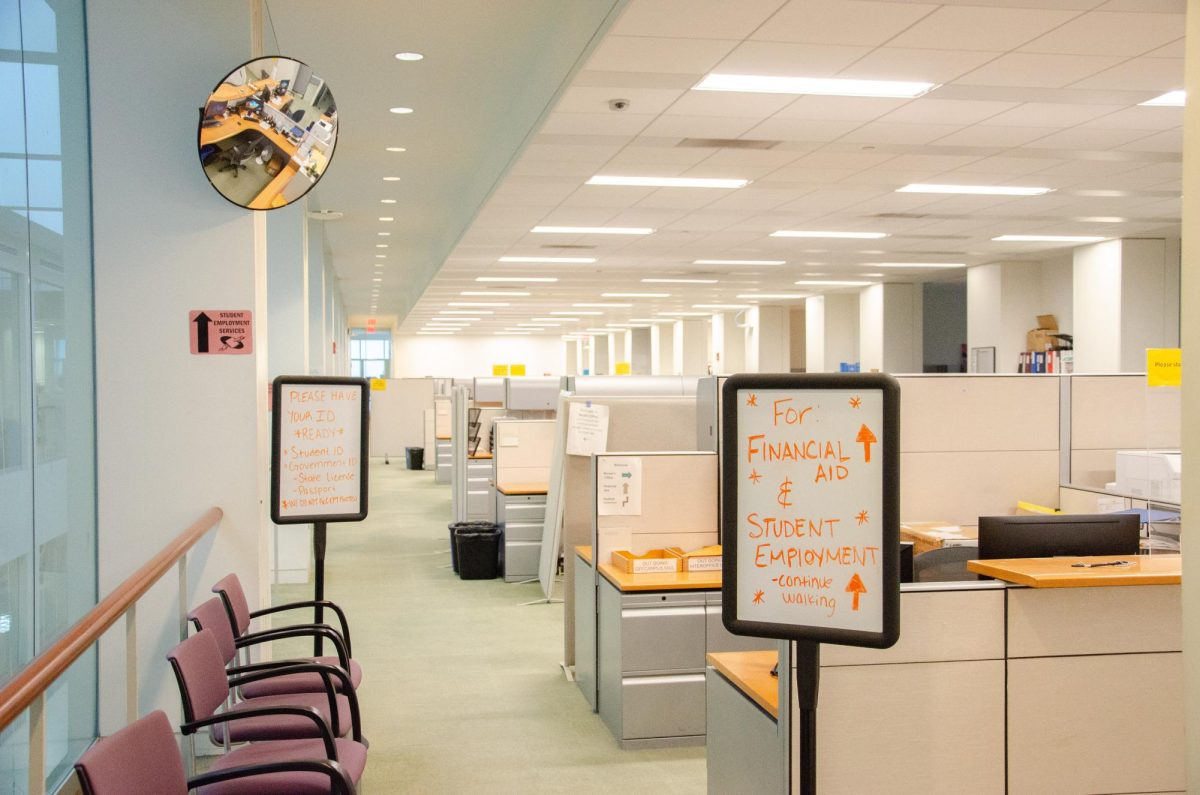UMass Boston employs hundreds of students each year—in fact, according to John Drew, the vice chancellor for enrollment management, just under 1,600 students worked at UMass Boston last year. Navigating the bureaucracy associated with Student Employment is notoriously difficult, but, as Drew explained, there’s a lot going on behind the scenes.
For example, each department handles the onboarding process individually. Each department has a managing checklist that they must complete to keep Student Employment Services up to date on the listing, and once the department finds a student, the Student Employment office steps in to handle their paperwork and communicate with Human Resources. According to the SES website, this process can take up to two weeks to complete. [1]
Drew encourages every department to utilize Handshake, a hiring platform like Indeed or ZipRecruiter that UMass Boston is affiliated with.
“One department may just decide to put some flyers up, or they may just have outreach to students, but in order for it to be visible for everyone, we want departments to use that central Handshake system as much as possible,” said Drew.
That said, some students found Handshake difficult to use. Drew described the platform as “a bit cluttered, and not so intuitive,” and added that Student Employment is thinking about ways to better utilize and organize the platform, including potentially providing guidance or training on how to use it. He added, “it’s a system that’s used by a lot of institutions, so I have to believe that, based on the number of schools that are using it, it’s a pretty good one.”
Drew wasn’t kidding—Handshake really is not that intuitive. Upon making an account, students are met with a sidebar with five different tabs, each with a unique user interface and layout. Of the nearly 19,000 jobs available to students on the app, only fifteen are tagged as “on-campus” for UMass Boston students. To even find the on-campus filter, students must click into an advanced filters window.
Counterintuitively, this filter can’t be found under the “location” filter. Of these 15 jobs, only seven are actually on campus, and some aren’t even offered by UMass Boston or its faculty. One of these listings, a “Growth hacker” position, appears to be a multi-level marketing scheme advertising a gig job. Suggested skills include “Hustler. You make things happen,” and “Passion for startups, marketing, and cheese. (We love cheese.)”
About a dozen students were spoken to about their experiences with Student Employment and Handshake, and none of theme complained about their experience with SES—by all accounts, the department does their best to work with students and expedite the hiring process. However, none of the students spoken to found Handshake to be an easy platform to use. In fact, many of the students who worked on campus or were employed through SES had not found their position through Handshake, but through word of mouth or job boards.
Of the students that did find their job on Handshake, all of them jumped into complaints about the platform. Several complained about spam emails they received from the platform or their issues with navigating it. Dakota Brown, a student who now works off-campus, said that his issues with the app completely turned him away from SES:
“A lot of the openings were either for graduate students or not even on campus. The majority were both, having mostly off-campus internships and not much else. The app was also often glitchy and many options were from past years that I assumed wouldn’t even be relevant now. Overall, the Handshake app is such a nuisance that I got a job off campus instead.”
Drew emphasized that Student Employment is trying to push for jobs not covered by federal work-study—what he calls “hourly” jobs.
“The way federal work-study works behind the scenes is 75 percent of your pay is covered through federal work-study money and 25 percent is covered by the department, and of course that makes it easier for a department to hire federal work-study students,” he said.
However, international students don’t have access to work-study and usually can’t work off-campus, increasing the need for these hourly jobs. In addition to urging departments that hire fewer students to create more positions, Drew explained that Student Employment will also be working with departments that hire dozens of students, such as IT, to see if they can offer even more positions and make the process easier.
On-campus jobs are often more than just jobs—they can act as an opportunity for students to connect with other students and staff, especially students who live off-campus. According to Drew, “Beyond just the dollars that they earn, [student employees] generally connect with a staff member, and they get a sense of belonging in our community. We want to make sure our managers understand that from their perspective, they may just be managing one or two students, but that connection might be critical in that student’s life.”
Hopefully, improvements to the Handshake process as well as other improvements in the works—like electronic forms, streamlined paperwork and new hiring checklists—will help smooth over recurring bumps in the road and make the process more seamless.
SOURCES:
[1] https://www.umb.edu/campus-life/current-students/student-employment/





















































